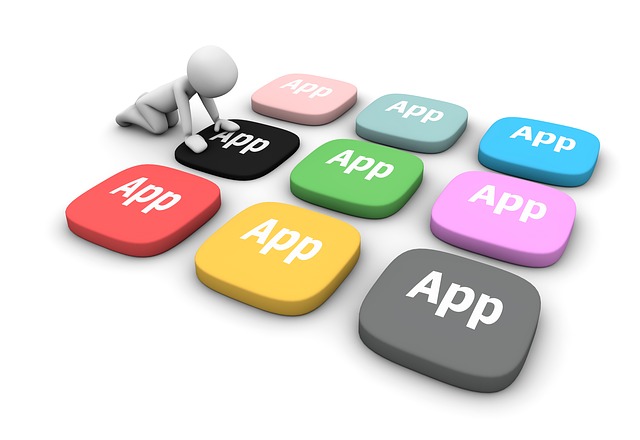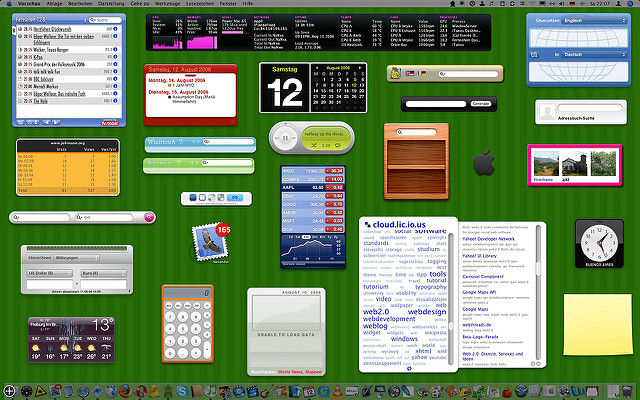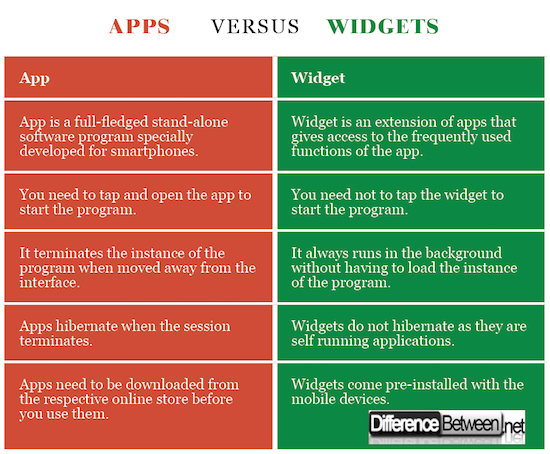Difference Between App and Widget
• Categorized under Technology | Difference Between App and Widget
See those tiny little icons when you flip the screen of your smartphone? Or see the menu that appears when you long press the home screen of your Android phone? Most Android phones come pre-built with those things. They are called widgets. It’s probably one of the best features of Android. Widgets are all the rage these days. Smartphones have definitely changed the way we interact with everything. First it’s the apps that made our phones smarter, and then comes the accessible rich applications called widgets. With the whole world at our fingertips, it seems we are carrying not less than a supercomputer in our pockets. Not only they supply useful information but also collect a host of data every minute of every second. Widgets are not apps; instead they are more like mini apps that are embedded in other applications such as the Home screen. This article explains the difference between apps and widgets.

What is an App?
Application, or commonly known simply as “app”, is a piece of downloadable software program that runs both online and offline on computers and mobile devices such as phones, tablets, laptops, etc. App is a generic term for a full-featured software program that allows you to perform specific tasks. Apps designed for desktop computers and laptops are mainly called desktop applications, whereas those are specially developed to be used on mobile devices are called mobile applications or mobile apps. They are mostly third-party programs that will run when you tap on the icon. They are simply links to certain programs that start when you tap the icon. There are mainly two types of apps – desktop apps and mobile apps. Desktop app is a full-fledged software program that runs stand-alone locally on a computer, whereas mobile apps are developed specifically to be run on small devices such as smartphones and tablets. Mobile apps are miniature versions of the programs with similar offerings those accessed on computers.

What is a Widget?
Widgets are also apps except they let you access the apps without opening them. Some applications replace icons for widgets to add an aesthetic appeal to the home screen. Technically, it’s an element of a graphical user interface (GUI) that comes in all shapes and sizes. Widgets are icons that link to programs except you do not need to tap them to start the program. Let’s take an example of a weather widget – it not only provides live weather information but also detailed weather reports and the best part, it updates automatically and runs continuously on the background. You can however tap the weather widget to access the full features of the app. In simple terms, widget can be referred to as a self-contained piece of code that is mostly a shortcut to a larger application. Widgets are more than just icons; they can be buttons, scroll bars, pull-down menus, on-off toggle, progress indicators, and more. Widgets also provide extension to an existing widget to describe how a particular widget behaves and responds to user actions.
Difference between App and Widget
Basics of App and Widget
Apps are full-fledged programs that are developed to perform specific tasks and they can be categorized into mobile apps and desktop apps. Mobile apps are the programs developed for small devices such as mobile phones and tablets, whereas desktop apps are stand-alone programs that run locally on a computer. Widgets, on the other hand, are self-contained mini apps that come in all shapes and sizes. Widgets are more like icons that link to programs.
Function of App and Widget
App is a full-featured program that you need to tap and open in order to enjoy the full services of the program. Apps can be multifunctional that let you do everything at once. Widgets are also apps except they always run in the background. Unlike apps, widgets are always active by default and you do not need to tap them to start the program.
Hibernate
Apps hibernate when the instance of that program is closed or terminated. Closing an app usually abandons its last state and it moves away from its interface. Opening it again will reload its executable code either completely or partially. In simple terms, close the app and it goes into hibernation. Widgets, on the contrary, always run in the background so they do not hibernate when you move away from the interface.
Visibility of App and Widget
A widget runs in the background which makes it hypothetically invisible to the user. It works behind the scenes without having to load the instance of the program every time you tap the icon. App, on the other hand, is visible to the user and it performs its activities in the foreground. However, the instance is closed when you move away from its interface.
Purpose of App and Widget
Both apps and widgets are different types of programs with different purpose. Apps are basically links that direct to third-party programs when you tap the icon. Apps need to be downloaded from the respective online store before use. The main purpose of app is to perform a particular task. Widgets are a miniature version of apps, more like an extension of app which makes the apps easily accessible on the home screen.
Apps vs. Widgets: Comparison Chart

Summary of App Verses Widget
Both apps and widgets are two sides of the same coin. They refer to different types of programs and serve different purpose. While apps are full-featured stand-alone software programs that are specifically designed for mobile devices such as smartphones and tablets. Widgets are more like an extension of apps that come pre-installed with the phones itself. Apps are programming applications that need to be downloaded before you can use them, whereas widgets are also apps except they run continuously and you need not to click on the widgets to start the programs.
Outside his professional life, Sagar loves to connect with people from different cultures and origin. You can say he is curious by nature. He believes everyone is a learning experience and it brings a certain excitement, kind of a curiosity to keep going. It may feel silly at first, but it loosens you up after a while and makes it easier for you to start conversations with total strangers – that’s what he said."
- Difference Between Serif and Sans Serif - April 22, 2024
- Difference Between HTML and Text - April 19, 2024
- Difference Between FTP and SFTP - April 16, 2024
Sharing is caring!
Search DifferenceBetween.net :
 Email This Post
: If you like this article or our site. Please spread the word. Share it with your friends/family.
Email This Post
: If you like this article or our site. Please spread the word. Share it with your friends/family.
Cite
APA 7
Khillar, S. (2018, May 31). Difference Between App and Widget. Difference Between Similar Terms and Objects. http://www.differencebetween.net/technology/difference-between-app-and-widget/.
MLA 8
Khillar, Sagar. "Difference Between App and Widget." Difference Between Similar Terms and Objects, 31 May, 2018, http://www.differencebetween.net/technology/difference-between-app-and-widget/.
1 Comment
Leave a Response
Written by : Sagar Khillar. and updated on 2018, May 31
References :
[0]Tarkoma, Sasu. Mobile Middleware: Supporting Applications and Services. New Jersey: John Wiley & Sons, 2009. Print
[1]Breslin, John G., Alexandre Passant, and Stefan Decker. The Social Semantic Web. Berlin: Springer, 2009. Print
[2]Nicol, Derk. Mobile Strategy: How Your Company Can Win by Embracing Mobile Technologies. Indianapolis: IBM Press, 2013. Print
[3]Image credit: https://pixabay.com/en/app-software-contour-settings-1013616/
[4]Image credit: https://www.flickr.com/photos/alexander_johmann/213426525
See more about : App, Widget


Thank you for explaining in a detailed yet simple manner for others to understand. Very informative.